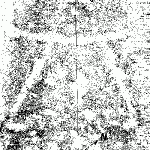TRACCE no. 9 – by Leo Dubal
2nd International Congress of Rupestrian Archaeology
2-5 October 1997 DARFO BOARIO TERME
The “historical sequence” of rock art starts with pieces with imitative vocation. They are isolated pieces, intimate, recluse. They are pieces of stolen life, which are not readily exhibite.
The “historical sequence” of rock art starts with pieces with imitative vocation. They are isolated pieces, intimate, recluse. They are pieces of stolen life, which are not readily exhibited. They are objects of cult, of devotion, for pardon or adoration, disposed in places difficult of access, sacralized, forbidden. Later, the “magical brotherhood of the gods” imposed itself: the engravings got aligned…This is the time of paradigmatic changes, for matrifocal to patriarchal form of social organisation, which shook the Neolithic ages, probably 5,000 years ago.
Man, self-aware, represents himself orthogonal, i.e., the builder, the imaginative being, able to compose with physical laws, with terrestrial gravitation. The realistic aspect is replaced by the image of orthogonality. Verticality is a sign of life, while horizontality, submitted to gravitation, is the sign of death (1).

For “worshipping observers” staring at the sky-line, the winter solstice sundawn should have been the perfect allegory of the death-rebirth duality. The Neolithic solar observatory of La Gardette (2) is indeed decorated by cruciform anthropomorphs looking at 125° N, the azimuth of the rising “new sun” in 5,000 BP, for 44.5° latitude N. Those “observers” are engraved with various levels of abstraction, ranging from a crooked idol with his feet turned inwards (see Fig. 1), to simple crosses. The “magical brotherhood of the gods” comes into the picture with the regular spacing between the “observers”: the Cevenole cubit of 55 cm (quite close to the Egyptian cubit of 52, 5 cm).
“About 5,000 BP, time becomes important, the sun and the moon being, for some reason, more noticeable” (4). While the observation of the winter solstice sundawn has probably been instrumental to the discovery of the solar calendar year of 365.24 days, the summer solstice seems to have captured attention only 1,000 years later. Recently, such a late Neolithic solar altar-observatory, located 280 km eastwards from La Gardette, has been identified: the so called “stele of the tribal chief” at Mont Bégo (5). The anthropomorph has his feet turned inwards, too, while his body – illuminated by the summer solstice rising sun, – and arms are oriented toward the four – NEWS – cardinal points.
References
(1) L. JOLY: Forme et signe, une geometrie originelle, TRICORNE, Genève (1980) ISBN 2-8293-0010-6
(2) L. DUBAL & F. TILLAULT: Evidence for a Cenevole Neolithic Solar Altar, NEWS 96 – Int. Conf. on Rock Art Research, Swakopmund (Namibia), Aug. 11-18 (1996)
(3) L. DUBAL, Tactigraphy, a New Method for Recording Prehistorical Rock Engravings, INORA, 10 (1995), p. 23
(4) D. L. CYR, Climate under Snowball Comets, (Sept. 11, 1997), stonevue@aol.com, see also: http://smallcomets.physics.uiowa.edu
(5) C. JEGUES-WOLKIEWIEZ, Des gravures de la Vallée des Merveilles au ciel du Mont Bego – temple luni-solaire du neolithique, Thèse UNSA, Nice, avril 1997
TRACCE no. ![]() special issue for RA Congress 1997
special issue for RA Congress 1997
![]()















Leave a Reply